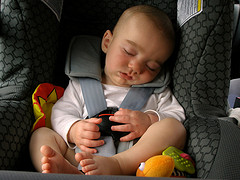The best accident is the one that never happens. When an accident does occur, minimizing injuries and preventing deaths is critical. Our firm has vast experience in plaintiff-side injury litigation, including Northern California child injury lawsuits. While we vigorously represent the wrongfully injured, we favor prevention over litigation — a sentiment shared by our clients who’d turn back time if they could and choose avoiding injury over receiving money damages. If an accident does occur, we believe in minimizing injuries and preventing fatalities. This post looks at two safety measures aimed at protecting child car accident victims, one that gives emergency responders vital information and another that addresses when you must replace safety seats after an accident.
WHALE Program Provides Responders with Useful Information About Young Children
The National Highway Safety Association (“NHSA”) is one of the partner organizations involved in the WHALE Program, which stands for “We Have A Little Emergency.” A program brochure notes that 63,000 children under age four were involved in car accidents in 2002 alone. If the adult(s) travelling with a young child cannot speak due to serious injury or death, emergency personnel may have a difficult time identifying the youth and any of his/her special needs. This information is vital. Simply knowing a child’s name can help ease fear, while information about an allergy can be a life-saver. Additionally, knowing who to call, such as a parent (assuming both were not in the car) or other relative, can ensure the proper people are notified of the situation. WHALE is about providing this information to the first responders.
 Started in the 1990s by a child care-giver named Connie Day, WHALE is an identification program. Parents or other adults can contact the program to receive an information card and plastic holder. After filling out the enclosed information card, parents can stick the self-adhesive holder to the backside of the child’s safety seat where others cannot see it. Stickers placed in the rear side car windows and the side of the safety seat itself let responders know to look for the information card. It provides parents peace of mind, makes an accident a little bit less frightening, and can even save a child’s life.
Started in the 1990s by a child care-giver named Connie Day, WHALE is an identification program. Parents or other adults can contact the program to receive an information card and plastic holder. After filling out the enclosed information card, parents can stick the self-adhesive holder to the backside of the child’s safety seat where others cannot see it. Stickers placed in the rear side car windows and the side of the safety seat itself let responders know to look for the information card. It provides parents peace of mind, makes an accident a little bit less frightening, and can even save a child’s life.
California is not one of the states that specifically takes part in the WHALE program. We encourage the state and local communities to take part in the program. In the meantime, we encourage individuals with small children to contact WHALE and receive a safety kit.
NHTSA Changes Recommendations on Replacing Child Safety Seats After an Accident
Of course, safety seats are much more than just a place to put a WHALE sticker! In a previous post (linked below), we discussed the type of seats appropriate for each age group. We are often asked about the rules for replacing child seats after an accident. Previously, the NHTSA recommended seats be discarded after any accident, no matter how minor. This recommendation has been changed in part because of instances in which children were riding without a safety seat because a replacement had not yet been acquired, perhaps due to finances or simply because was in the process of being shipped.
The current NHTSA guidance suggests replacing child safety seats after a moderate or severe crash, but says automatic replacement is not necessary after a minor incident. In order to be considered minor, a crash must meet all of the following requirements: 1) The vehicle could be driven away from the accident scene; 2) The door nearest to the seat was not damaged; 3) None of the vehicle’s occupants suffered injury; 4) The air bags did not deploy; and 5) There is no visible damage to the seat.
Safety First, Vigorous Representation When Necessary
The WHALE program and the NHTSA safety seat guidance are two of the many ways we can keep our community’s youngest members safe in cars and other motor vehicles. We encourage parents and caregivers to take efforts to prevent child car accident injuries and to minimize injuries (including mental/emotional trauma) in case an accident does occur. If, however, someone else’s negligence caused a crash that left you and/or your child injured, call our Oakland child injury law firm. We can help you recover damages, including money for lifelong treatment/care if the child’s injuries are permanent and severe.
See Related Blog Posts:
Keeping Kids Safe and Advocating for the Smallest of Car Crash Victims
California Ushers in New Year with Enhanced Child Safety Law (2012)
(Photo by Jim Champion)
 San Francisco Injury Lawyer Blog
San Francisco Injury Lawyer Blog

